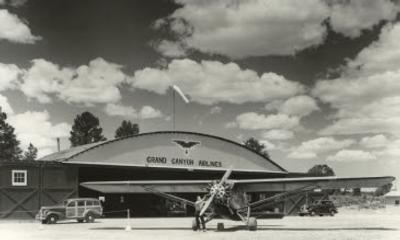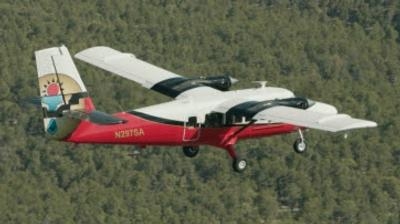First Tour Was Conducted Aboard A Stinson Detroiter SM-1
This month marks the 90th anniversary of Grand Canyon Scenic Airlines (GCSA), the world's longest-running aerial tour company.

The story of Grand Canyon Scenic Airlines began in 1927. That year, Parker Van Zandt left his position at Ford Motor Company to pursue his dream of flying passengers from one rim of the Grand Canyon to the other. Along with investors, he began Scenic Airways which became one of the first operators to venture into the virtually untapped industry of aerial tourism. The company’s first commercial air tour took place on Oct. 3, 1927 in a 6-passenger Stinson Detroiter SM-1.
In this age before television, nationally distributed newspapers, magazines and the internet, most people in the United States (and across the world) had not seen the Grand Canyon, much less flown over it. With Scenic Airways’ launch, demand for Grand Canyon flights gradually increased. During this era, air tours were promoted for their novelty as well as their ability to bring tourists to the canyon.
On Nov. 1, 1928, Van Zandt announced Scenic Airways had purchased 278 acres of land in Phoenix for $125,000 and begun constructing the airport that would become Sky Harbor International Airport. That same month, Scenic Airways operated the first commercial flight from Sky Harbor to Rocky Point, Mexico.
But a tumultuous future awaited Scenic.
In August 1929, an economic recession caused investor funding to dry up leading to a steep decline in business. The Stock Market crashed on Oct. 29, 1929, ushering in the Great Depression.
In 1930, although Scenic Airways was forced to close and liquidate its assets, Arizona Businessmen Jack Thornburg and Irving Kravitz resurrected Scenic Airways under a new name - Grand Canyon Airlines. The new business was incorporated in Arizona on April 29, 1931 with Grand Canyon Airlines operating commercial tours by May 1931.

Throughout the ‘30s and ‘40s, Grand Canyon Airlines would continue to change owners. By 1953, the Hudgins brothers purchased the fledgling airline and would eventually sell the company to Elling Halvorson in 1966. At the time, Halvorson was the owner of a construction company charged with the large and logistically complex project of building a water pipeline from the North Rim to the South Rim of the Grand Canyon. Halvorson had initially used helicopters to transport lumber, piping and other materials over the canyon, reaching otherwise treacherous areas. Locals watching this construction take place began to ask if they, too, could fly across the canyon gorge via Halvorson's helicopters. Recognizing the demand for such rides, Halvorson quickly developed aerial tour operations utilizing helicopters. He set his sights on adding airplanes and purchased Grand Canyon Airlines from the Hudgins family.
During this same time, John and Elizabeth Seibold founded Scenic Airlines (similar name but not related to Scenic Airways), which operated out of North Las Vegas, Nevada. They would eventually partner with Halvorson and Grand Canyon Airlines to cross-promote experiences in both the domestic and international tourism markets.
Fast forward to the 2000s when Grand Canyon Airlines bought Scenic Airlines from the Seibolds to become Grand Canyon Scenic Airlines. In addition to flying daily tours to the Grand Canyon, GCSA added locations such as Antelope Canyon, Rainbow Bridge, Monument Valley, Horseshoe Bend and Tower Butte. Over the course of its 90-year history, the company evolved into the largest and longest-running aerial tour company and has flown more than 100 million passengers.
(Images provided GSCA news release)
 Unfortunate... ANN/SportPlane Resource Guide Adds To Cautionary Advisories
Unfortunate... ANN/SportPlane Resource Guide Adds To Cautionary Advisories ANN FAQ: Turn On Post Notifications
ANN FAQ: Turn On Post Notifications ANN's Daily Aero-Term (04.29.24): Visual Approach Slope Indicator (VASI)
ANN's Daily Aero-Term (04.29.24): Visual Approach Slope Indicator (VASI) ANN's Daily Aero-Term (04.28.24): Airport Marking Aids
ANN's Daily Aero-Term (04.28.24): Airport Marking Aids ANN's Daily Aero-Linx (04.28.24)
ANN's Daily Aero-Linx (04.28.24)




